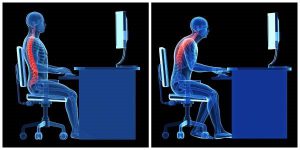Ergonomics
How posture affects the spine
In a person that sits with normal posture, the curvatures of the spine assume an “S-shape.” This allows even distribution of body weight loads throughout the spine. Over-time with prolonged sitting, the postural muscles of the back can fatigue leading to the adoption of poor posture. In a person with sitting posture the natural curvatures of the spine can become “C-shaped which leads to an abnormal distribution of body-weight loads on the spine. In particular, excessive stress is placed on the lower back, neck and upper thoracic areas which can lead to symptoms such as pain and stiffness.

Good posture: S-shaped spine Poor posture: C-shaped spine
What is ergonomics?
Ergonomics utilises sciences such as anatomy, physiology and engineering to design tools that allow people to work more safely and comfortably in their work environments to help reduce the risk of poor health outcomes and improve performance.
How can Capital Physiotherapy implement ergonomics to help you?
Capital Physiotherapy can incorporate ergonomics into their physiotherapy assessment and treatment to help improve posture in the workplace and thus reduce symptoms associated with poor sitting posture. Our physiotherapists can provide advice about alterations to the workplace environment to improve aspects such as desk height, chair set-up and positioning of desk items to aid the adoption of good posture. At Capital physiotherapy, we can also determine which muscles and joints are affected by poor posture and provide treatment to reduce symptoms associated with muscle tightness, joint stiffness, muscle weakness and altered muscle activation.
Some of our treatments may include:
- Taping
- Massage
- Muscle activation, strengthening and stretching exercises
- Dry needling
- Hands-on manual therapy
- Education about posture
If you like this post do subscribe to on our youtube channel and follow us on instagram
Posted by Capital Physio -Leah Christoforou

